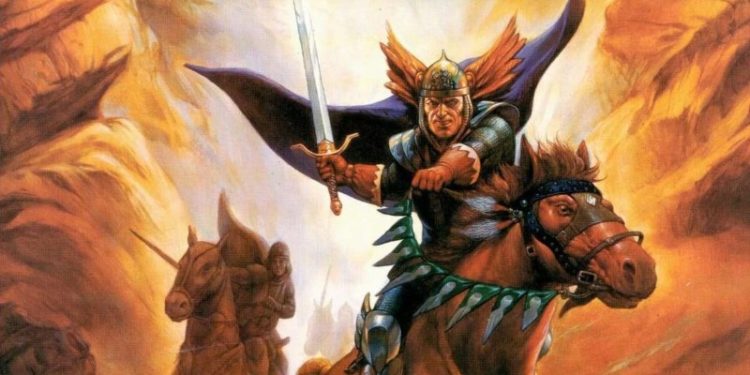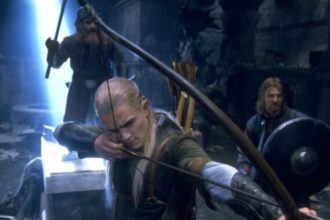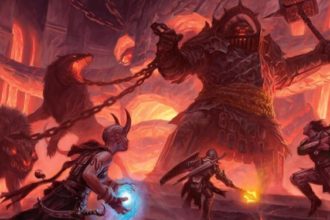The Fighter Class, Part Four

After a few weeks of talking about other things, I’m ready to tackle the next stage of the fighter in D&D, which of course means Advanced Dungeons & Dragons, Second Edition, as well as the Complete Fighter’s Handbook, Player’s Option: Combat & Tactics, and Player’s Option: Skills & Powers. If that makes it sound like I have a lot to cover today… well, yeah.
Part One | Part Two | Part Three | Part Four
Player’s Handbook
The rules of the Player’s Handbook fighter are so similar to the post-UA 1e fighter that I would almost think about posting a link to the Part Two article and calling it a day.
- Minimum Strength of 9. That makes this one of the easiest classes to qualify for.
- I glossed over this before, so let me say that having no “off-topic” prereqs (as contrasted with the paladin’s minimum Cha of 17) means that in most stat-generation methods, the fighter’s advantage, compared to the paladin and ranger, is that they aren’t “wasting” good scores on things that won’t do much for them in combat.
- To put that another way, if you want to play a melee combatant who relies on main force and durability, you’re probably playing a fighter – almost no special features, but their freedom with ability scores is a great passive boost. They also get more direct mileage out of good ability scores, for the life of the campaign, than any other 2e class – thieves get an AC bump and a skill bump from high Dex, but no attack or damage boost for their melee backstabbing, and their ranged damage will be no better than fair.
- d10 HD.
- A THAC0 that improves 1 point per level. They start off just as bad as everyone else (THAC0 20), which… is not a decision I agree with.
- Proficient in all armor and shields. They can become proficient in any weapon, though they only start with 4 weapon proficiency slots. They gain new slots faster than any other class.
- They start with 3 nonweapon proficiency slots, and gain a new one every three levels. That’s the low side of normal. (Since I didn’t mention this back in the History of the Rogue, why the heck are rogues so bad at non-weapon proficiencies in 2e? Whatever.)
- Weapon specialization: +1 to hit, +2 to damage. Only warriors (fighters, paladins, rangers) ever gain more than one attack per round, unless I’ve missed a reference, and specialization improves that by 1 per 2 rounds.
- In principle, weapon specialization is the defining fighter feature that no one else can touch. In practice, just about every other remotely weapon-using class eventually had some way to pick up weapon specialization, though in some cases that had to wait until Skills & Powers – and that’s far from the worst sin one would have to lay at the feet of the Player’s Option
- The fighter’s followers and elites (still showing up at 9th level) got a real shot in the arm. Your lieutenant is still about the same, ranging from 5th level with one magic item to 7th level with an array of magic items, but you get a better collection of followers, and your elite followers are serious business – anything from 10 1st-level knights in full panoply of war (personal armor, horses with barding, and so on) to 20 2nd-level berserkers. Clerics could potentially have greater numbers, but not followers with better armament or training.
Pretty minimal change, as I said. No real thematic shift, because the fighter’s theme can’t shift. Or they’re not willing to dig in and really explore what the fighter can be in a definite way. Whichever.
Complete Fighter’s Handbook
The first of the 2e splatbooks – inaugurating the whole tradition of class splatbooks, in fact – is the Complete Fighter’s Handbook. In addition to roleplaying guidance and kits for fighters, it expands 2e’s combat rules, weapon proficiency rules, and so on. It’s a lot of patches and new subsystems on a game that had been out for, oh, several hours by that point. I’m going to try to hit the high points, but this touches enough parts of the combat system, in its mad quest to make 2e AD&D more simulationist, that it skates closer to being a new half-edition than one might expect from a splatbook.
The less said about the 2e crafting system found in this book, the better. (I am not one for saying less.)
The majority of the kits here are more like 5e’s backgrounds with minor tradeoffs, but a few of them are just a hot mess of balancing enormous mechanical advantages with roleplaying disadvantages. Cavalier kit, I am looking at you. Also, a lot of these kits get into allowing paladins or rangers to specialize in a weapon, as the core feature of the kit. A warrior class with a kit is 2e’s initial answer to a lot of 1e’s classes, because not only does this include the cavalier, it also has samurai, gladiators, berserkers (steer clear of this kit, their berserk effect is a hot mess), swashbucklers, and so on. I appreciate the reminder that all of these things fall under the fighter rubric, but they all seem to land on either “hilariously overpowered” or “+3 to one kind of reaction roll and -3 to another.” The only general boost is that kits grant warrior types bonus nonweapon proficiencies, and I am always a fan of that.
Oh, and just so I’ve acknowledged this, the kits come from a place of absolutely phenomenal 1980s white cishet privilege. The conversation has moved enough on this that even starkly retrograde new releases don’t go where this does with its assumptions of Western-European-as-default.
A lot of the book gets into single-class campaigns or even single-kit campaigns, and there’s a collection of archetypal personalities to help distinguish characters in such a setup. This is pretty strong material, as it’s actually about helping players present more memorable and compelling fighters.
Next we get into new combat rules, which is mostly collections of situational modifiers and new maneuvers that fighter-types might want to try. There’s a ground-up revision of approaches to weapon proficiencies, suggesting that someone realized giving fighters just four starting slots and asking them to spend two on weapon specialization (because you are just playing wrong if you could specialize and don’t) means that fighters have no real breadth of choice. There’s also specialization in fighting styles, which is sort of hilarious in making single-weapon fighting a better defensive style than weapon-and-shield, great weapon fighting faster than single-weapon, shield fighting just becomes a crummy version of two-weapon fighting… in short, every style’s native strengths are tossed out.
There’s a lot more here, but taken together it’s just the low-hanging fruit of supporting fighter-heavy campaigns in other cultures, and for campaigns that crave deep simulationism. There are rules for jousting, weapons and armor for less technologically advanced settings, rules for damaging armor in the course of a fight, rules for each possible kind of head cover (“no cover” is like saying “I hope the DM doesn’t remember the Called Shot rules”), and so on. Some of the maneuvers are cool, if you’ve already decided that 1e or 2e are for you.
Player’s Option: Combat & Tactics
This book is more about a variant of core and corner-case combat mechanics than anything specific to the fighter class. I can scarcely imagine anyone committing all of these rules and fiddly modifiers to memory, but then I think I have a Player’s Option-era DM screen around here somewhere, so TSR knew it too. On a positive note, there are some rules that try to make one-on-one duels more exciting to watch. It’s more or less a tabletop version of Street Fighter.
The one section that does directly discuss the fighter is the recapitulation and revamp of weapon proficiencies, which veers ever closer to being a feat system. Not that the style specializations weren’t already a feat system, mind you.
- Spending a weapon proficiency slot on shield proficiency increases the AC bonus granted by shields larger than bucklers, and lets you block additional opponents with your shield.
- Spending a weapon proficiency slot on armor proficiency lets you ignore half of the armor’s weight when totaling your encumbrance.
- Addressing that “everyone can specialize” thing, there’s now a mid-step between proficiency and specialization called Expertise. It grants the extra attacks, but not the attack or damage bonuses. As if the flat adds are the important thing there.
- Specialization is once again fighter-only (but wait until we get to Skills & Powers, where it isn’t anymore).
- Weapon Mastery comes next: Mastery (+3 to hit, +3 damage) at 6th level; High Mastery (increase weapon speed by one category, and crit on 16-20 rather than PO:CT’s optional 18-20) at 9th level; and Grand Mastery (+1 attack per round and +1 die size step… so longsword becomes a 1d10 vs S-M/1d20 vs L+ weapon) at 12th
- Look, either you agree that weapon specialization is fundamentally bad for the game or you don’t – but I really hope that everyone sees how hyper-specialization is turning a choice point into a non-choice. There is absolutely nothing the game could offer you, as a fighter, that competes with the next grade of mastery, and the next, and the next. It’s just a stronger and stronger disincentive to even consider using a weapon other than your favored weapon.
- Weapon specialization tiers do different things for things other than melee weapons.
- Style specialization gets recapped, with additional missile style specialization and horse archery specialization. The style specializations don’t have mastery tiers, so they’re basically fine.
- Special Talents are the true feat precursors.
- Alertness changes your “surprise” die to 1 on a d10. The surprise system of die sizes is such a mess.
- Ambidexterity reduces your two-weapon fighting penalties.
- Ambush lets you make a proficiency roll to gain automatic surprise, even if your targets are highly surprise resistant.
- Camouflage is a Hide skill for people who don’t have a Hide skill. 2e’s multiple systems of stealth and perception intersect badly here.
- Dirty Fighting is a chance at a once-per-lifetime-of-the-target +1 to hit. Man, is this a piece of crap purchase.
- Endurance is pretty vaguely worded, unless you are using the optional and insanely punitive Fatigue rules introduced in this book.
- Fine Balance is a way to bring a tightrope-walking skill into 2e, and also mitigate fighting-in-awkward-conditions penalties. Let me just say that rolling a proficiency check to find out if you get a bonus to another check is the worst.
- Iron Will is a combination of 3e’s Iron Will feat (but at half strength, +1 instead of +2) and Diehard feat (but at half strength – you stay conscious to -5 rather than -10).
- Leadership makes you a bit better at battlefield command, if that’s a thing in your campaign.
- Quickness lets you make a proficiency check to get an initiative bonus. It’s an unreliable Improved Initiative; -2 in 2e is roughly as good for you as +4 in 3.x. Though of course you roll initiative every round… which means you also have to roll a Quickness check round.
- Steady Hand lets you go last in a round and sacrifice any extra attacks you would make in that round to negate some penalties for shooting at medium or long range. Hot tip, as we know from the advantage mechanic, unless you’re wiping out more than roughly 4 points of penalty, or you’re shooting your very last black arrow at Smaug, Smaug the Golden, Smaug the Impenetrable… just take two shots.
- Trouble Sense is yet another proficiency to interact with the surprise system, but specifically deals with negating sneak attacks and flank attacks. Since no monsters have a Backstab feature and thief NPCs are going to have just as much trouble using it against PCs as PC thieves do against NPCs, this is mostly about negating the to-hit bonus for back attacks and flank attacks.
The point, then, is that all of these are Warrior proficiencies, and most of them are also Rogue proficiencies. It’s hard to see how even the best of these (Ambidexterity or Iron Will) could compete with stacking more and more weapon mastery. I don’t think anyone has missed my feelings on this, but man, late 2e design is just a hot mess.
Player’s Option: Skills & Powers
This book offers a point-buy approach to class features, and every class chooses from the same slate of kits – which ultimately makes kits more like 5e’s Backgrounds than like 5e’s subclasses. (In case you haven’t been hanging on every little release from WotC for the past couple of years, I mention this because Mearls has compared 5e’s subclasses to 2e’s kits – but then he was talking about the kits of the Complete handbooks, not the Player’s Option series.)
Anyway, as you might expect if you’ve ever looked real hard at a point-buy system for races and/or classes, you can guess that this is awfully easy to powergame, by picking drawbacks that don’t hurt and dropping benefits you don’t expect to care about. The best I can say for it is that you can use what’s here to make an entirely passable barbarian class. Just about all of the optional features presented here could leaven the fighter’s near-absence of interesting features, and this is great if you know you’re getting into a war epic or a domain-management game. One wonders why these things are class features and not nonweapon proficiencies, though.
Having said that, there’s a wildly more interesting game implied in Player’s Option rulebooks than the game ever explores. Hand out more class-building points as major quest rewards, or as part of completing a challenging training montage. Maybe create a way to dip into other classes’ options as a further story reward. Suddenly 2e is a game with organic character growth. This also takes a ton of pressure off of choices made at character creation. Didn’t buy Leadership, because you never thought you’d get an army to lead, but now you’ve survived a few major battles and it makes sense for you to gain that feature? Hey look, we have a mechanism for that! No more campaign-long buyer’s remorse!
The non-standard features that you can trade off to buy highlight a lot of different emphases to customize the fighter, and if repackaged cleverly, you have a great subclass system on your hands all of a sudden. Movement speed, d12 hit dice, increased resistance to spells or poison, benefits to every element of mass combat and domain management… the fighter shifts from an Everyman to properly representing the breadth of concepts that the class description always claimed.
Thanks for coming with me on this journey through 2e. I have no doubt in my mind that there are Dragon Magazine articles and other variant fighter options that I’m overlooking; the one I know about is Dark Sun’s Dragon Kings supplement. I wonder this kind of thing a lot, but – if you played a Dark Sun character from 1st level to Dragon Kings epic level, please tell me about it in the comments, because I would absolutely bet that less than 1 person in every 300 sales of that book got any use out of it beyond an interesting read. Let’s be real, though, fighters were not the interesting part of that book! Preservers, defilers, and psionicists are where it’s at in Dragon Kings.



